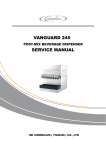Download Training Manual Wilshire Juice
Transcript
WILSHIRE JUICE TRAINING MANUAL ✔ CARBON DIOXIDE ✔ WATER ✔ SYRUP/CONCENTRATE ✔ MECHANICAL ✔ REFRIGERATION ✔ CONTROLS & ELECTRICAL Blank Page Wilshire Juice Training Manual Wilshire Juice Training Manual The products, technical information, and instructions contained in this manual are subject to change without notice. These instructions are not intended to cover all details or variations of the equipment, nor to provide for every possible contingency in the installation, operation or maintenance of this equipment. This manual assumes that the person(s) working on the equipment have been trained and are skilled in working with electrical, plumbing, pneumatic, and mechanical equipment. It is assumed that appropriate safety precautions are taken and that all local safety and construction requirements are being met, in addition to the information contained in this manual. To inquire about current revisions of this and other documentation or for assistance with any Cornelius product contact: IMI Cornelius Inc. Corporate Headquarters One Cornelius Place Anoka, MN 55303-6234 U.S.A. Internet: www.cornelius.com In the U.S.A.: Outside the U.S.A.: phone: 763-421-6120 800-238-3600 FAX: 800-535-4235 phone: 763-421-6120 FAX: 763-422-3297 Email: [email protected] Trademarks and copyrights: Aurora, blendanator, Cornelius, Decade, Hydro Boost, Sitco, Rancor, Spirit, UF-1, Vanguard, Venture, Olympus, and Vista are registered trademarks of IMI Cornelius Inc. Optifill trademark is pending. This document contains proprietary information and it may not be reproduced in any way without permission from Cornelius. Printed in U.S.A. Copyright © 1999-2002, All Rights Reserved, IMI Cornelius Inc. Wilshire Juice Training Manual NOTES: _______________________________________________________________________ _______________________________________________________________________ _______________________________________________________________________ _______________________________________________________________________ _______________________________________________________________________ _______________________________________________________________________ _______________________________________________________________________ _______________________________________________________________________ _______________________________________________________________________ _______________________________________________________________________ _______________________________________________________________________ _______________________________________________________________________ _______________________________________________________________________ _______________________________________________________________________ _______________________________________________________________________ _______________________________________________________________________ _______________________________________________________________________ _______________________________________________________________________ _______________________________________________________________________ _______________________________________________________________________ _______________________________________________________________________ _______________________________________________________________________ TABLE OF CONTENTS INTRODUCTION - - - - - - - - - - - - - - - - - - - - - - - - - - - - - - - - - - - - - - - - - - - - - - 1 Preview Questions - - - - - - - - - - - - - - - - - - - - - - - - - - - - - - - - - - - - - - - - - - - - - 1 Key Things To Know / Do - - - - - - - - - - - - - - - - - - - - - - - - - - - - - - - - - - - - - - - 1 Overview - - - - - - - - - - - - - - - - - - - - - - - - - - - - - - - - - - - - - - - - - - - - - - - - - - - 2 Product Description - - - - - - - - - - - - - - - - - - - - - - - - - - - - - - - - - - - - - - - - - 2 Dimensions & Capacities - - - - - - - - - - - - - - - - - - - - - - - - - - - - - - - - - - - - - - 3 All Quantum™ Dispensers: - - - - - - - - - - - - - - - - - - - - - - - - - - - - - - - - - 3 Quantum™ 1000, Single Flavor: - - - - - - - - - - - - - - - - - - - - - - - - - - - - - - 3 Quantum™ 2000, Two Flavor: - - - - - - - - - - - - - - - - - - - - - - - - - - - - - - - 3 Quantum™ 3000, Three Flavor: - - - - - - - - - - - - - - - - - - - - - - - - - - - - - - 3 Quantum™ 4000, Four Flavor: - - - - - - - - - - - - - - - - - - - - - - - - - - - - - - - 3 SYSTEM DETAILS - - - - - - - - - - - - - - - - - - - - - - - - - - - - - - - - - - - - - - - - - - - - - 4 Water - - - - - - - - - - - - - - - - - - - - - - - - - - - - - - - - - - - - - - - - - - - - - - - - - - - - - 4 Water Quality - - - - - - - - - - - - - - - - - - - - - - - - - - - - - - - - - - - - - - - - - - - - - 4 Water Flow - - - - - - - - - - - - - - - - - - - - - - - - - - - - - - - - - - - - - - - - - - - - - - - 4 Adjusting Flow Rates - - - - - - - - - - - - - - - - - - - - - - - - - - - - - - - - - - - - - - - - 4 Concentrate - - - - - - - - - - - - - - - - - - - - - - - - - - - - - - - - - - - - - - - - - - - - - - - - - 4 Miscellaneous Concentrate Tips - - - - - - - - - - - - - - - - - - - - - - - - - - - - - - - - - 5 SLJ Units - - - - - - - - - - - - - - - - - - - - - - - - - - - - - - - - - - - - - - - - - - - - - - 5 QLT Units - - - - - - - - - - - - - - - - - - - - - - - - - - - - - - - - - - - - - - - - - - - - - 5 Setting Ratios - - - - - - - - - - - - - - - - - - - - - - - - - - - - - - - - - - - - - - - - - - - - - - - - 5 Mechanical - - - - - - - - - - - - - - - - - - - - - - - - - - - - - - - - - - - - - - - - - - - - - - - - - - 6 Concentrate Pump Disassembly: - - - - - - - - - - - - - - - - - - - - - - - - - - - - - - - - - 6 SLJ Rinse/Flush Valve Rebuilding: - - - - - - - - - - - - - - - - - - - - - - - - - - - - - - - 7 SLJ Valve Mixing Block Rebuilding: - - - - - - - - - - - - - - - - - - - - - - - - - - - - - 9 Miscellaneous Mechanical: - - - - - - - - - - - - - - - - - - - - - - - - - - - - - - - - - - - 11 Refrigeration - - - - - - - - - - - - - - - - - - - - - - - - - - - - - - - - - - - - - - - - - - - - - - - 12 Water Thermostat - - - - - - - - - - - - - - - - - - - - - - - - - - - - - - - - - - - - - - - 12 Concentrate Thermostat - - - - - - - - - - - - - - - - - - - - - - - - - - - - - - - - - - - 12 Control Relay - - - - - - - - - - - - - - - - - - - - - - - - - - - - - - - - - - - - - - - - - - 12 Refrigerant Solenoid Valve - - - - - - - - - - - - - - - - - - - - - - - - - - - - - - - - - 12 Heat Exchanger Assembly - - - - - - - - - - - - - - - - - - - - - - - - - - - - - - - - - 12 Compressor - - - - - - - - - - - - - - - - - - - - - - - - - - - - - - - - - - - - - - - - - - - 13 Condenser - - - - - - - - - - - - - - - - - - - - - - - - - - - - - - - - - - - - - - - - - - - - 13 Condenser Fan - - - - - - - - - - - - - - - - - - - - - - - - - - - - - - - - - - - - - - - - - 13 TABLE OF CONTENTS Wilshire Juice Training Manual TABLE OF CONTENTS Wilshire Juice Training Manual Dryer - - - - - - - - - - - - - - - - - - - - - - - - - - - - - - - - - - - - - - - - - - - - - - - 13 Air Flow - - - - - - - - - - - - - - - - - - - - - - - - - - - - - - - - - - - - - - - - - - - - - - - - 13 Refrigerant Charging - - - - - - - - - - - - - - - - - - - - - - - - - - - - - - - - - - - - - - - 13 Filter/Dryer Replacement - - - - - - - - - - - - - - - - - - - - - - - - - - - - - - - - - - - - 14 Condenser Cleaning - - - - - - - - - - - - - - - - - - - - - - - - - - - - - - - - - - - - - - - - 14 Miscellaneous Refrigeration: - - - - - - - - - - - - - - - - - - - - - - - - - - - - - - - - - - 15 Controls and Electrical - - - - - - - - - - - - - - - - - - - - - - - - - - - - - - - - - - - - - - - - - 16 TROUBLE SHOOTING - - - - - - - - - - - - - - - - - - - - - - - - - - - - - - - - - - - - - - - - - 17 ATTACHMENTS - - - - - - - - - - - - - - - - - - - - - - - - - - - - - - - - - - - - - - - - - - - - - - 19 REVIEW - - - - - - - - - - - - - - - - - - - - - - - - - - - - - - - - - - - - - - - - - - - - - - - - - - - - 21 Wilshire Juice Training Manual INTRODUCTION 1. PREVIEW QUESTIONS Check your current knowledge by taking a few minutes to answer the following questions: 1. Water and concentrate thermostats are interchangeable? _____ True _____ False The transformer does NOT control the cooling system? _____ True _____ False 3. Condenser airflow passes over the compressor first? _____ True _____ False 4. ”Ratio” refers to the amount of water required to dilute one part of concentrate? _____ True _____ False 5. O-rings may be installed dry (lubrication is not recommended)? _____ True _____ False 2. KEY THINGS TO KNOW / DO ✔ Work Safely! Always unplug/disconnect the power to the dispenser before servicing, and get help lifting the unit if it must be removed from the counter. ✔ Make certain that the water line has adequate pressure at all times! ✔ Learn to use a good quality volt-ohm meter. Proper electrical trouble shooting is impossible without it! © 1999, IMI Cornelius Inc. -1- INTRODUCTION 2. Wilshire Juice Training Manual 3. OVERVIEW Transformer & Relay Concentrate Compartment INTRODUCTION Water Cooling Coil Fan Compressor Condenser Air intake through bottom 3.1 Product Description Dispensers manufactured under the Cornelius/Wilshire name have a long and distinguished history of service in the frozen juice industry. As with their previous names, (Alco and Reynolds) they have set the standard for utility, reliability and long service lives against which their competitors are judged. These dispensers have undergone an evolutionary development over the years in order to take advantage of newer technologies and yet, retained their original character and simplicity of design. While pumping systems have undergone changes to better meet the needs of our customers, and cabinet design has been given a new and more pleasing look, the refrigeration system has remained true to its original design. There are two models of post-mix juice dispenser: • • Slim Line Juice (SLJ) comes in 1, 2, 3, and 4 flavor (2 and 4 are the most popular). It can use a refillable or disposable juice container. Quick Load Tube (QLT) is almost identical to the SLJ except for the pump and juice pouch tray. The one, two, and three flavor dispensers use a single frame and a separate pump assembly for each flavor. The four flavor dispenser is two two-flavor units merged together. Everything is interchangeable except the frames. -2- © 1999, IMI Cornelius Inc. Wilshire Juice Training Manual Each dispenser has two cooling evaporators, one for water and one for concentrate. Each evaporator has its own thermostat. The dispensers are not self defrosting. A lighted merchandiser is an option. 3.2 Dimensions & Capacities All Quantum™ Dispensers: - - - - - - - - - - - - - - - - - - 1.6 – 2.2 oz./sec. 115 VAC, 60 cycle, single phase, 9.43 amps - - 220 VAC, 50 cycle, single phase, 5 amps - - - - 34 1/2” H (with 4” legs), 27 1/4” D - - - - - - - - - - - - - 4” back, 12” top - - - - - - - - - - - -3/8” SAE male flare - - 100 psi max. static, 20 psi min. dynamic Quantum™ 1000, Single Flavor: Dimensions- - - - - - - - - - - - - - - - - - - - - - - - - 10 3/4” W Shipping weight - - - - - - - - - - - - - - - - - - - - - - - 125 lbs. Quantum™ 2000, Two Flavor: Dimensions- - - - - - - - - - - - - - - - - - - - - - - - - 10 3/4” W Shipping weight - - - - - - - - - - - - - - - - - - - - - - - 130 lbs. Quantum™ 3000, Three Flavor: Dimensions- - - - - - - - - - - - - - - - - - - - - - - - - 14 3/4” W Shipping weight - - - - - - - - - - - - - - - - - - - - - - - 145 lbs. Quantum™ 4000, Four Flavor: Dimensions- - - - - - - - - - - - - - - - - - - - - - - - - - - 19” W Shipping weight - - - - - - - - - - - - - - - - - - - - - - - 156 lbs. © 1999, IMI Cornelius Inc. -3- INTRODUCTION Flow Rate - - - Electrical rating- - - - - - - - - Dimensions- - - Clearance - - - Water Connection- - - - - - - - - Wilshire Juice Training Manual SYSTEM DETAILS 1. WATER 1.1 Water Quality Water quality has an affect on juice dispensing systems. • odor • taste • clarity/foaming Water filtration is recommended to assure the best beverage taste. 1.2 Water Flow Inlet water pressure should be regulated to 45 psi max. (3.1 bar) to prevent damage to pump tubing. 1.3 Adjusting Flow Rates SYSTEM DETAILS Adequate water flow is necessary and should be at least 3.0 ounces per second (89 ml) at the inlet. 2. CONCENTRATE • Concentrate should be stored frozen and put into a cooler 72 hours before use. Rapid cooling, such as in a sink of hot water, adversely affects flavor and leads to service calls. • Proper loading of concentrate is important. Improper loading is a major source of service calls. • Concentrates vary in viscosity and mixing valves must be adjusted accordingly. • When changing concentrate, be sure to check the concentrate container O-ring for damage. It should be clean and wet with concentrate or a food grade lubricant. • Shake or stir pulp based concentrates. • When changing flavors, be sure to flush the system and reset the pump. • Nozzles should be cleaned daily. Remove the nozzles and wash in warm soap solution. Rinse with clean water, lubricate the O-ring, and replace nozzle. • Flushing daily and sanitizing weekly is recommended. -4- © 1999, IMI Cornelius Inc. Wilshire Juice Training Manual 2.1 Miscellaneous CONCENTRATE Tips SLJ Units If the concentrate causes a false refill light, the refill circuit can be bypassed (jumped). Jumper the two probes just above the dispense-flush lever. QLT Units QLT’s usually use 5 to 1 concentrate which can look thawed in the bag but still be semi-frozen. Concentrate that is too thick to flow properly may cause a false refill light because the syrup may not have filled the tube. When there is no concentrate in the tube, the pump motor runs with no drag. The concentrate sensor measures current draw on the motor and assumes that since there is no concentrate in the tube that the concentrate supply is empty. 3. SETTING RATIOS • A refractometer or hydrometer must be used to measure the post-mix ratio. • Ratios are sometimes set by taste but this is not recommended. SYSTEM DETAILS © 1999, IMI Cornelius Inc. -5- Wilshire Juice Training Manual 4. MECHANICAL At least once a year the concentrate pumps should be checked, cleaned, and the pump tubing replaced. 4.1 Concentrate Pump Disassembly: 1. See “Installation And Service Manual” for pump platform removal procedure. Housing 2. Remove four thumb screws, housing cover, and impeller. Rotor Assembly SYSTEM DETAILS Thumb Screws 3. Remove and replace clamps and pump tubing with new ones (pump tubing and clamps kit p/n 4509B). Clamps Pump Hose 4. Clean components and check that the rollers spin freely. Impeller Rollers -6- © 1999, IMI Cornelius Inc. Wilshire Juice Training Manual 4.2 SLJ Rinse/Flush Valve Rebuilding: Valves should be rebuilt if they are leaking. Cornelius supplies a kit which includes all the O-rings (p/n 45026100). 1. See “Installation And Service Manual” for pump platform removal procedure. Valve Assembly 2. Remove four screws and lift valve assembly up, disconnect wires in the back of the valve. Screws 3. Remove two screws holding the valve to the bracket. SYSTEM DETAILS Syrup Line Port 4. Loosen screw that holds cam-lock washer and disconnect the syrup line. © 1999, IMI Cornelius Inc. Fastening Screw & Cam-lock Washer -7- Wilshire Juice Training Manual Bottom Of Valve 5. Remove four screws from bottom of valve. Screws & Plate Top Of Valve 6. Pull off bottom of valve and center section. Bottom of Valve Center Section Of Valve 7. Rebuild the valve and reassemble. Be sure the cam-lock washer is in the groove of the syrup line. NOTE: O-rings should be lubricated with sanitary lubricant. SYSTEM DETAILS NOTE: Red O-ring at bottom of valve plate must be a tear resistant teflon. Use p/n 31525064. -8- © 1999, IMI Cornelius Inc. Wilshire Juice Training Manual 4.3 SLJ Valve Mixing Block Rebuilding: Valves should be rebuilt if they are leaking. Cornelius supplies all the parts necessary for rebuilding. Loosen cam lock-washer 1. Loosen cam lock-washer on both water lines. cam lockwashers SYSTEM DETAILS Screws 2. Remove two screws on the bottom of the plate. © 1999, IMI Cornelius Inc. -9- Wilshire Juice Training Manual Solenoid Wires 3. Remove Solenoid wires. 4. Remove nut and Solenoid coil. Solenoid Coil Nut SYSTEM DETAILS Screws On Front Of Plate 5. Remove all screws. Screws 6. Separate valve halves. Flow Control Sleeve - 10 - Flow Control Piston © 1999, IMI Cornelius Inc. Wilshire Juice Training Manual 7. If necessary, remove and replace flow control and check valve components. Check Valve 8. Rebuild the valve and reassemble. Replace all O-rings making sure they are not pinched or twisted. Be sure the cam-lock washers are in the grooves of the water lines. NOTE: O-rings should be lubricated with sanitary lubricant. 4.4 Miscellaneous Mechanical: • • © 1999, IMI Cornelius Inc. - 11 - SYSTEM DETAILS SLJs can be converted to QLTs (see IMI Cornelius QLT Training video). There is one motor per concentrate pump. DC motors are used to allow variable speeds. Some juice dispensers have speed switches which change the motor voltage from 28 to 18. This slows the motor to accommodate very low water pressure. This is especially useful when high concentrate ratios are used. Wilshire Juice Training Manual 5. REFRIGERATION The two evaporators in our design are independently controlled so that they don’t both cool at once. This prevents the cabinet or water thermostats from over-cooling one evaporator while trying to satisfy the other. This is accomplished by using two thermostats wired parallel, a control relay to connect them to the compressor and a liquid line solenoid valve to isolate the water cooling evaporator during cabinet cooling cycles. During a cabinet (concentrate) cooling cycle, the water may require cooling. When this occurs, the water thermostat closes, sending current to the control relay. At this point, the compressor is already running, so the current is passed on via the red wire leading to the refrigerant solenoid valve. Once this valve is opened, refrigerant flow is diverted to the water coil for cooling. The cooling cycle is relatively short for average incoming water temperatures. If incoming water is warm, it may become necessary to hook up to a chilled water line from a beverage system, in order to keep up with peak or high demand periods. Setting the water thermostat to a colder temperature does not increase the efficiency of the water coil and may result in the freeze-up of the water coil during off peak hours. Once the water thermostat is satisfied, the refrigerant solenoid will close and cooling will be restored to the cabinet. Water Thermostat Controls the refrigerant solenoid valve and the cooling of the water evaporator coil. Connects to the normally closed relay terminal. Concentrate Thermostat SYSTEM DETAILS Controls cooling of the concentrate compartment and operation of the start relay. Connects to the normally open relay terminal and the relay coil. Note: These thermostats are of different sensitivities and must not be substituted for one another. The same two parts are used in all models (all years). Control Relay Allows thermostats to individually control compressor operation without short cycling. This relay is also used in all models (all years). Refrigerant Solenoid Valve Cuts off the flow of refrigerant to the water-cooling coil when the water thermostat is satisfied. Heat Exchanger Assembly Consists of the capillary tubes for the concentrate compartment and the suction line and insulation. The capillary tube is soldered to the suction line to prevent condensation and balance system pressure. If replacement becomes necessary, the entire assembly must be replaced as one. - 12 - © 1999, IMI Cornelius Inc. Wilshire Juice Training Manual Compressor Moves the refrigerant through the system. Pressurizes the refrigerant for heat dissipation in the condenser. Condenser Dissipates heat from the compressor and refrigeration action. Condenser Fan Circulates air across the compressor and condenser to facilitate heat removal. Dryer Cleans and removes moisture from the refrigeration system. A standard dryer was in use for the SLJ until recently. The dryer currently in use is a Parker style dryer. The Parker distinguishes itself by having two inlets and two outlets. When ordering a new dryer, it is important to specify which dryer is needed. The dryer should be replaced any time the refrigeration system is opened. 5.1 Air Flow 5.2 Refrigerant Charging Charging any capillary tube controlled system requires accurate charging equipment and technique. The Cornelius/Wilshire dispenser is no exception. The amount of refrigerant in the system actively determines the operating pressures and temperature of its evaporators. It is because of this that it’s necessary to utilize a refrigerant scale or graduated charging cylinder whenever charging a system. Whenever investigating a suspect sealed system of this type, it’s important to remember that its operating pressures are to a great degree determined by load, ambient temperature and condition. If the unit appears to be under charged, check first for a dirty condenser. If the unit is constantly running but not cooling, the © 1999, IMI Cornelius Inc. - 13 - SYSTEM DETAILS Airflow in earlier units such as the first revision SLJ model was brought through louvered side panels and directed across the compressor and through the condenser. The second generation SLJ with the smooth side panels gets its airflow from the bottom and directs it first through the condenser and then across the compressor. On all models, the airflow passes from the fan blades into the condenser. This increases the efficiency of the refrigeration system but allows dirt to build up where it is difficult to see or remove. On the positive side, the condenser is designed to maximize airflow and minimize dirt buildup. Even so, the condenser should be cleaned yearly, and checked whenever routine maintenance is performed. Wilshire Juice Training Manual problem may be a low charge. If a low charge is suspected, it is recommended that the system be evaluated and leak tested by standard methods. NOTE: Hooking up a high side hose to a system with only 6.25oz of refrigerant causes a quarter or more of the charge to backup into the hose, immediately resulting in an incorrect reading. It is for this reason that operating pressures are not published. Since the initial production of the SLJ/Quantum dispenser, the amount of the refrigerant charge has changed. Earlier units specify a 5.Ooz charge while later units specify a 6.25oz charge. The reason for this change was driven by field service issues. While the 5oz charge produces the optimum cooling temperatures, a slight under charge from this critical point can cause a flash freeze in the water evaporator inlet. By increasing the charge to 6.25oz, we have increased the buffer zone between the correct charge and an under charge without any significant performance loss. Changes to the refrigeration system were not necessary to make this adjustment. Early units with a 5oz charge on the nameplate may be recharged to 6.25oz if refrigeration service is called for. SYSTEM DETAILS 5.3 Filter/Dryer Replacement The style of filter dryer utilized in the Cornelius/Wilshire juice dispenser has recently changed. The dryer previously in use was a standard configuration Alco dryer with one inlet and one outlet. Our new dryer is of a different configuration. Instead of the standard configuration, this dryer has two inlets and two outlets. The two inlets are for the refrigerant line from the condenser and a process tube. The two outlets are for the refrigerant line leading to the liquid line solenoid valve and the capillary tube that controls the concentrate evaporator. 5.4 Condenser Cleaning To clean the Condenser or change the fan motor follow this procedure. 1. Disconnect the power cord then remove the drip tray, splash panel, top panel, and both side panels. - 14 - © 1999, IMI Cornelius Inc. Wilshire Juice Training Manual 2. Remove four screws on front holding electrical box and two screws on each side of the fan shroud. Remove Two Screws On Each Side Of Fan Shroud Remove Four Screws In Front 3. Pull fan shroud forward. Fan Shroud SYSTEM DETAILS Fan 4. Clean condenser with brush and compressed air. If necessary, remove three screws on each side of the fan and move it out of the way. Condenser 3 Screws On Each Side 5.5 Miscellaneous Refrigeration: • • The water inlet valve solenoid assembly should be replaced as a unit. The water inlet valve solenoid assembly has a Y-strainer that may need periodic cleaning. © 1999, IMI Cornelius Inc. Water Inlet Valve solenoid - 15 - Wilshire Juice Training Manual 6. CONTROLS AND ELECTRICAL l • Transformer blue leads are 26 VAC and go to the pumps, red leads are 24 VAC and go to the merchandiser. Blue leads go to pumps The unit’s ON/OFF switch may be on the underside of the unit or on the inside of the door. There is also a switch on the bottom of the door that turns on and off as the door is opened and closed. Both of these switches turn off the pumps but not the refrigeration. SYSTEM DETAILS • Red leads go to merchandiser ballast board - 16 - © 1999, IMI Cornelius Inc. Wilshire Juice Training Manual TROUBLE SHOOTING TROUBLESHOOTING QLT DRINK QUALITY PROBLEMS ACTUAL PROBLEM & SYMPTOMS Concentrate too cold: • • • • • Low brix False refill light Poorly mixed drink Unmixed concentrate at bottom of cup Poor flow rate Concentrate too warm CUSTOMER REACTION Decrease water flow • • • • • Increase water flow • High brix Piercing device created a “flap” when it pierced through the pouch • Low brix • False refill light • Floats higher in the cup indicating high brix © 1999, IMI Cornelius Inc. NOTE: After 2-4 hours the concentrate will match the cabinet temperature becoming less viscous resulting in low brix Decrease water flow • • • • • Might correct brix False refill light Poorly mixed drink Pulsing/splashing dispense Unmixed concentrate at bottom of cup NOTE: Correct by rotating piercing device 90-180°F Increase water flow • Might lower brix • Drinks taste weak - 17 - TROUBLE SHOOTING Warm Hydrometer Might correct brix False refill light Poorly mixed drink Pulsing/splashing dispense Unmixed concentrate at bottom of cup NOTE: After 2-4 hours the concentrate will match the cabinet temperature becoming more viscous resulting in high brix Wilshire Juice Training Manual TROUBLESHOOTING QLT DRINK QUALITY PROBLEMS ACTUAL PROBLEM & SYMPTOMS Pouch in holder wrong (flow restriction) • Low brix • False refill light Pump slide not fully engaged • Low brix • False refill light Sticky pump rollers • Low brix Ambient water to dispenser CUSTOMER REACTION Decrease water flow • • • • • Decrease water flow • Can’t achieve good brix • False refill light • Poorly mixed drink Decrease water flow • Can’t achieve good brix • False refill light • Poorly mixed drink Service call / complaint • Drinks above 45°F during peak volume • Exceeds drink capacity of 20 oz. per minute 1/4” water line to dispenser TROUBLE SHOOTING • Poor flow rate • High velocity dispense - 18 - Might correct brix False refill light Poorly mixed drink Pulsing/splashing dispense Unmixed concentrate at bottom of cup NOTE: Must supply 3/8” chilled water line to dispenser to generate unlimited drink capacity. Decrease water flow • • • • • Might correct brix Poorly mixed drink High velocity dispense Pulsing/splashing dispense Unmixed concentrate at bottom of cup © 1999, IMI Cornelius Inc. ATTACHMENTS The following attachments should be included with this lesson: Minute Maid Orange Juice 6L Pouch Helpful Hints guide SLJ1000-1 Voltage Regulator Board Installation Instructions Installation Instructions Wilshire QLT180 VRB INSTALLATION INSTRUCTIONS WILSHIRE QLT180 VOLTAGE REGULATOR BOARD (VRB) The VRB is located in the front electrical box directly behind the lower splash panel. Remove the drip tray and splash panel to gain access to the electrical box. QLT180 Voltage Regulator Board Installation Instructions 1. Disconnect the 5 wire harnesses from the VRB and remove the VRB assembly by loosening two Phillips screws. 2. Remove the screw, lock washer, flat washer, rectangular insulator pad, round insulator, and nut that secure the regulator heat sink to the VRB mounting bracket. Separate the VRB from the bracket by gently squeezing the tips of the white plastic standoffs. 3. Reinstall the replacement VRB by reversing the above procedures. 4. Attach the five wire harnesses to the VRB as shown. IMPORTANT: The regulator mounting hardware must be installed as shown in order to allow heat dissipation from the regulator and to prevent the regulator from grounding. Failure to install the hardware properly may cause damage to the VRB. PART NUMBER REFERENCE 45138001 .....VRB for McDonald’s QLT 45559 ...........VRB Assembly (includes VRB, bracket, standoffs and regulator mounting. hardware) 45004 ...........Mounting Kit (regulator mounting. hardware) © 1999, IMI Cornelius Inc. All Rights Reserved Do not copy without permission -1- Form No. TP00910 © 1999, IMI Cornelius Inc. - 19 - ATTACHMENTS Wilshire Juice Training Manual ATTACHMENTS Wilshire Juice Training Manual QLT Juice Dispenser Wiring Installation Instructions IMI Cornelius QLT Training video tape - 20 - IMI Cornelius QLT Training © 1999, IMI Cornelius Inc. Wilshire Juice Training Manual REVIEW DATE: _______________________________________________ NAME: _______________________________________________ LOCATION: __________________________________________ The following questions summarize important points in this training lesson. REVIEW 1. What function does the refrigerant solenoid valve perform? A. Turns the compressor on/off B. Controls refrigerant pressure. C. Controls refrigerant flow to the water coil. D. Controls cabinet temperature. 2. The water and cabinet thermostats can be interchanged. _____ True _____ False 3. Power for the compressor flows through? A. The water thermostat B. The concentrate thermostat C. The control relay D. All of the above. 4. The transformer output is direct current (DC). _____ True _____ False 5. Air is sucked into the unit and exhausted through the condenser? _____ True _____ False 6. Ice buildup on the interior cabinet walls is: A. a normal part of the dispenser operation B. due to the thermostat being set too cold C. an indication that the concentrate has not been correctly thawed D. all of the above. © 1999, IMI Cornelius Inc. - 21 - REVIEW Wilshire Juice Training Manual 7. The voltage regulator board provides DC power for the pump motor. _____ True _____ False 8. Pump hoses should be replaced? A. monthly B. whenever flavors are changed C. annually D. when they wear out. 9. If the juice machine has been laid down on its side, it should be allowed to stand upright for at least one hour before starting. _____ True _____ False 10. Ratio is a measure of the amount of water verses concentrate in the finished juice drink. _____ True _____ False 11. Brix is a measurement of the dissolved solids in the finished drink. _____ True _____ False 12. The knob on the mixing valve adjusts concentrate flow. _____ True _____ False 13. On the SLJ/Quantum series dispensers, the pump motor and solenoid valves are wired parallel with one another. _____ True _____ False 14. The pump motor will rotate in the wrong direction if wired incorrectly. _____ True _____ False 15. The QLT circuit board may be substituted for the SLJ circuit board. A. once the pump assembly has been updated B. whenever the SLJ board malfunctions C. only on dispensers that are being converted to QLT applications D. Both A & C. - 22 - © 1999, IMI Cornelius Inc. Wilshire Juice Training Manual 16. The SLJ and QLT circuit boards wire in the same way. _____ True _____ False 17. The SLJ circuit board uses a continuity test to check for the sold out or refill condition. _____ True _____ False 19. The QLT circuit board differs from the SLJ primarily in the way they sense the sold out or refill condition. _____ True _____ False © 1999, IMI Cornelius Inc. - 23 - REVIEW 18. The function of the speed switch is to: A. help dispense drinks faster by increasing water velocity B. slow down the dispense rate when ice is used C. allow for low water pressure brixing of higher ratio concentrates D. keep busy waitresses from overflowing drinks. Wilshire Juice Training Manual NOTES: _______________________________________________________________________ _______________________________________________________________________ _______________________________________________________________________ _______________________________________________________________________ _______________________________________________________________________ _______________________________________________________________________ _______________________________________________________________________ _______________________________________________________________________ _______________________________________________________________________ _______________________________________________________________________ _______________________________________________________________________ _______________________________________________________________________ _______________________________________________________________________ _______________________________________________________________________ _______________________________________________________________________ _______________________________________________________________________ _______________________________________________________________________ _______________________________________________________________________ _______________________________________________________________________ _______________________________________________________________________ _______________________________________________________________________ _______________________________________________________________________ - 24 - © 1999, IMI Cornelius Inc. IMI Cornelius Inc. One Cornelius Place Anoka, MN 55303-1592 U.S.A. Part No. TP00908 May 10, 2002


































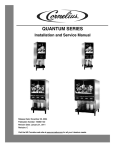
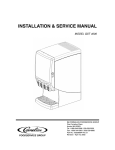
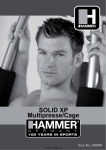
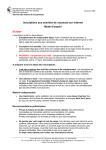
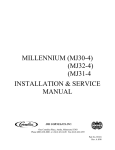
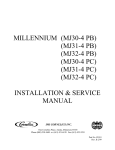
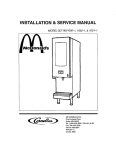


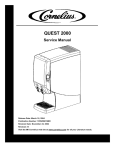
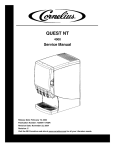
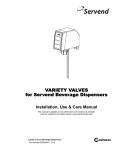

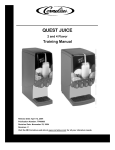
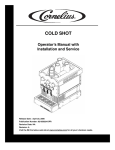
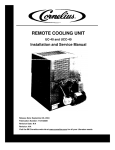
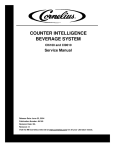
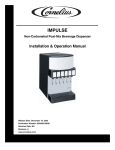
![Service Manual FCB Pinnacle 2 and 4 Flavor [ 005271 ]](http://vs1.manualzilla.com/store/data/006038828_1-2ffb9d6cd82d544c3f733521619945ce-150x150.png)
